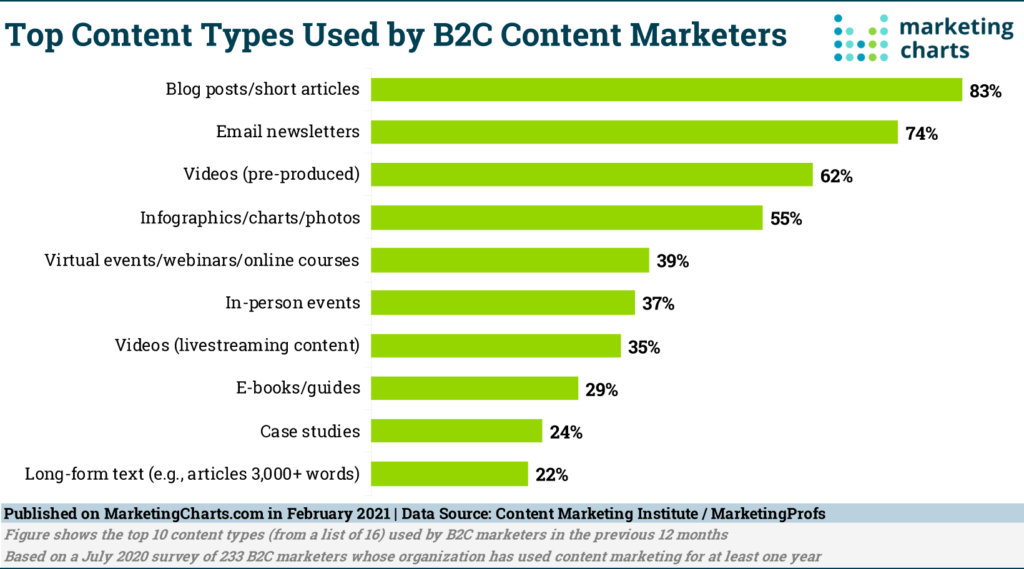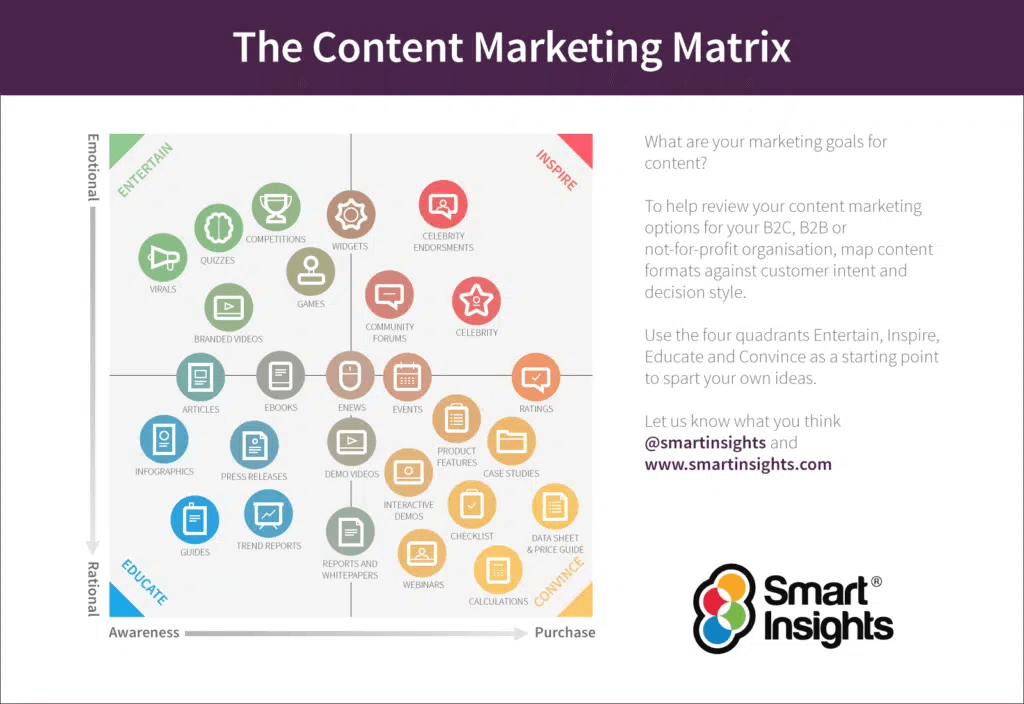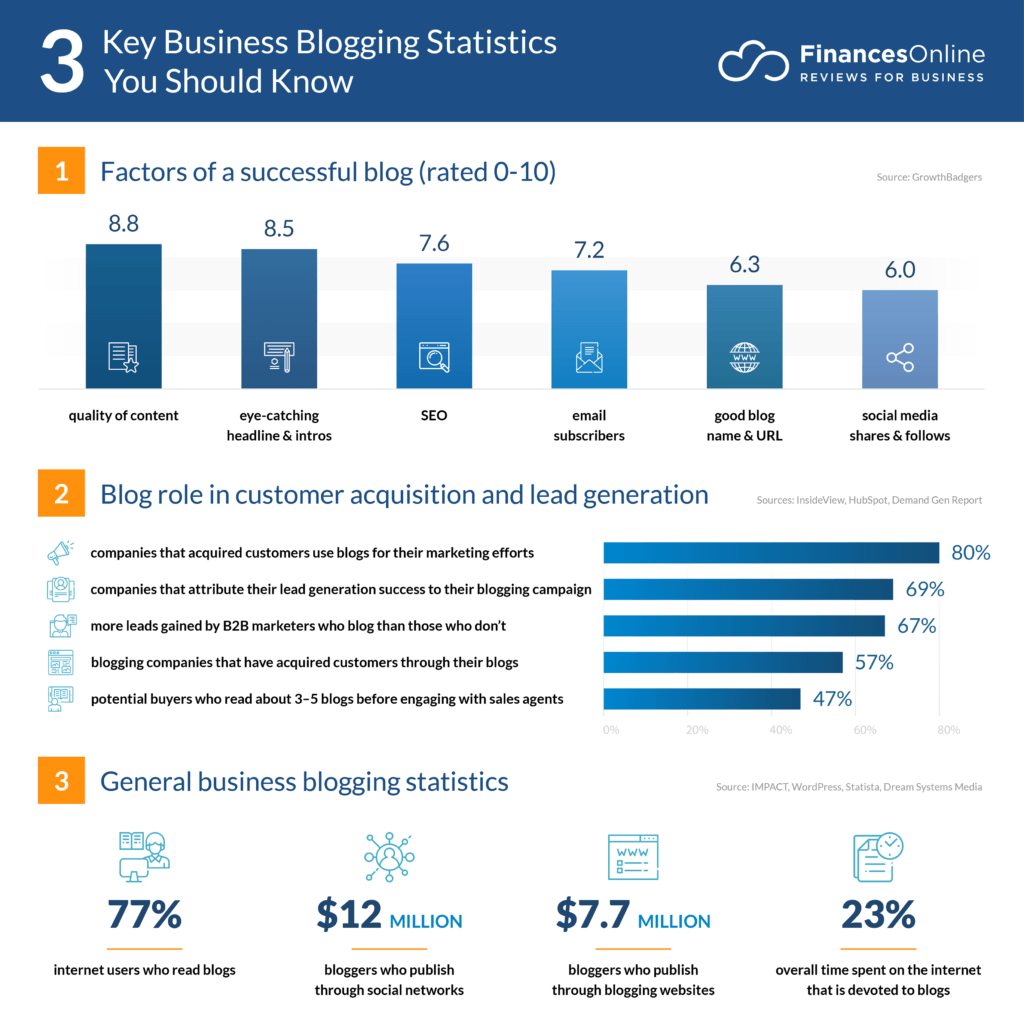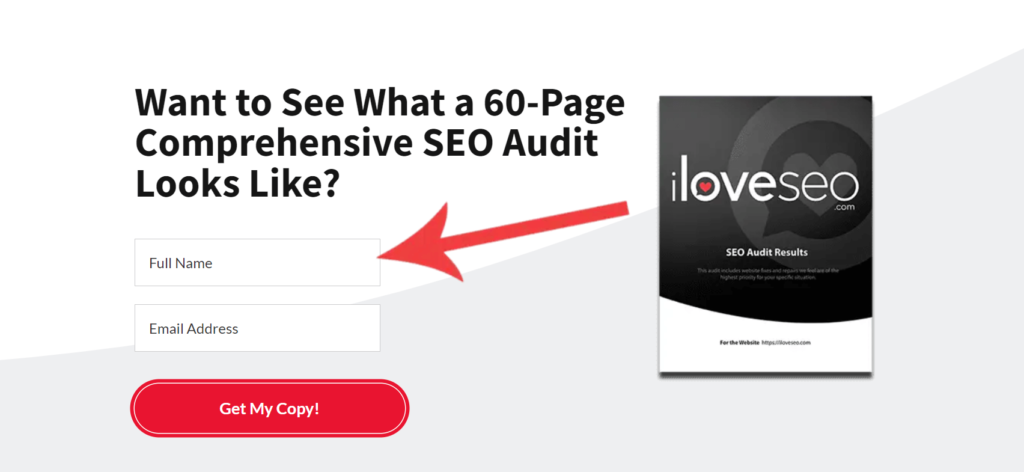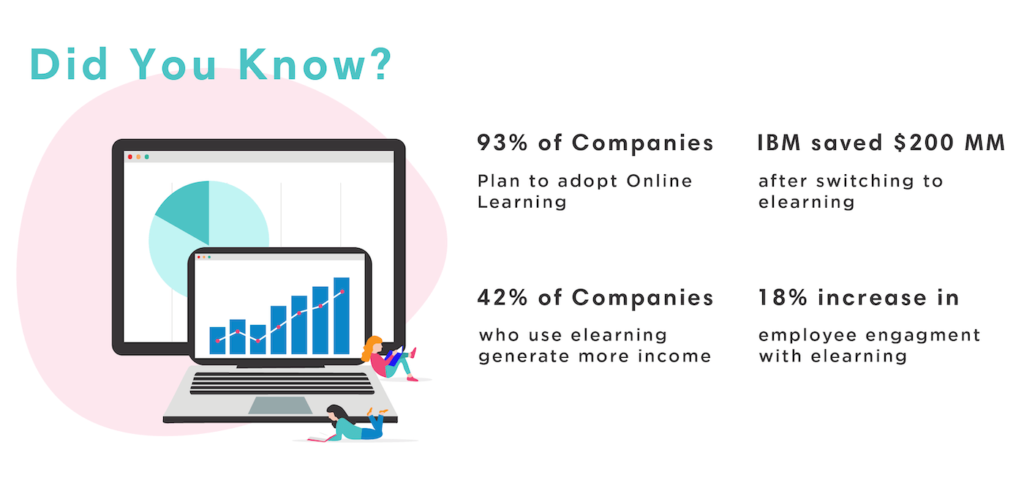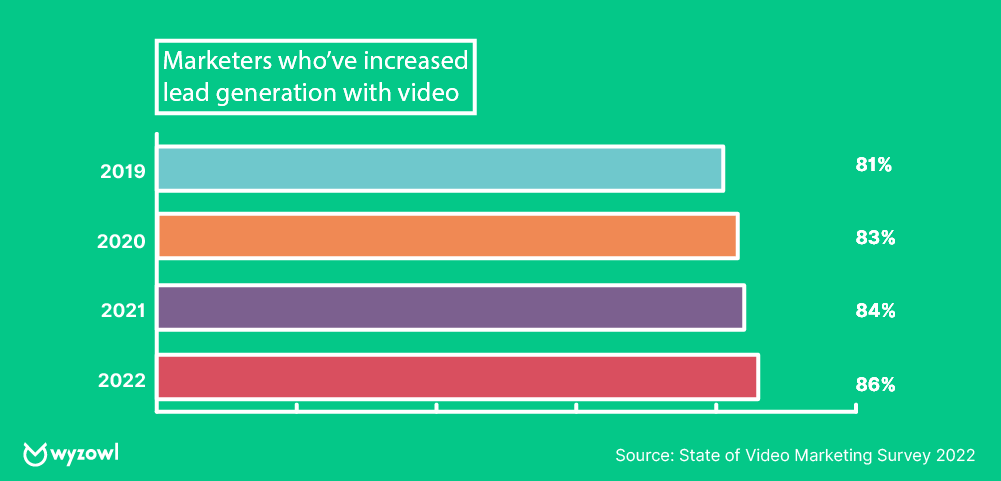Focusing on the different content types you can use in your SEO content strategy is never an exercise to take lightly. This can mean the difference between success and failure of your digital marketing efforts.
There are several types of content that you’re likely to encounter on your way through the web. Some of them are blog posts, some are eBooks, some are podcasts, and some are infographics. The key thing to remember is that each of the different content types has its own purpose and should be used appropriately.
Content marketing is essential for businesses who want to succeed online. In order to write effective content, however, you need to know what kind of content works best for your audience. But first, you have to know your audience well to be effective.
Without knowing your audience first, you won’t understand how to win them over with the right kind of content.
Content Types: How to Use Them to Your Advantage
There are many different types of content out there. From blog posts to infographics, videos, podcasts, etc. But how does each type of content help your brand stand out? What makes it unique? And how do you decide which ones to focus on?
In our opinion, there are three main types of content that organizations tend to use. They are:
- Product/service-based
- Brand awareness
- Content marketing
Each of these categories contains several subcategories, but let’s take a look at some examples of each category and see how you could apply them to your own work.
Product/Service-Based Content
This is the most common form of content that we all create. It can be anything from an infographic to a blog post or even a video. The key here is that this content should be about something that your audience cares about. If they don’t care about it, then why would you?
Brand Awareness Content
A lot of people think that brand awareness content is just for big brands like Coca Cola or Nike. However, it doesn’t have to be expensive to produce. In fact, it can be as simple as creating a short video with a catchy title. This type of content will get shared more than any other kind of content because it’s so easy to share.
Content for Content Marketing
This is probably the most important type of content that you need to create. It has become increasingly popular over the past few years. Why? Because it helps businesses build their online presence by providing information that their customers want.
If you’re looking to improve your website’s performance, you may be wondering if there’s a way to increase its traffic. There are many ways to boost your site’s visibility, including social media marketing, search engine optimization (SEO), and paid advertising.
If you’ve been thinking about starting a podcast, you might be wondering where to start. Here are five tips to help you get started.
The following from MarketingCharts.com shows statistics for the different types of content used by B2C digital content marketers:
What Are the Different Content Types?
The different content types you can use for SEO include, but are not limited to, the following:
- Articles
- Emails
- Blog Posts
- Guides
- Case Studies
- Ebooks
- E-Courses
- Video content
- Email Marketing
- Infographics
Diversifying and using a variety of content types in your SEO campaign effectively can lead to better results, rather than focusing on one single type of content.
Why Are Content Types Important?
Content marketing is one of those things that people either love or hate. There are probably many reasons why you might dislike it, but there are plenty of good reasons to like it as well. Content marketing is often seen as something that is done solely for the purpose of generating leads and sales. But what happens when we look beyond just lead generation and sales conversion? What about the fact that content marketing helps us build trust with our audience? Or how it can help us generate brand awareness?
The truth is, content marketing offers a lot of benefits. In fact, here are three of the most significant ones.
Differentiate Yourself From Competitors
Differentiation is key to success in today’s market. If you don’t stand out from the crowd, no one will find you. This is where content marketing really shines. When you publish unique pieces of content that are tailored specifically towards your target audience, you become that much more relevant to them. You are able to differentiate yourself from your competition because you aren’t simply trying to sell products to everyone. Instead, you offer value to your customers. This makes you stand out from your competitors and gives you the edge over them.
Build Relationships
When you write great content, you are building relationships. These relationships are built on trust and authenticity. Your audience trusts you because they know you care about them and understand their needs. They feel like you are someone they can connect with. And that connection creates loyalty. Loyalty drives repeat purchases. Repeat purchases mean more revenue for your business. So, as long as you continue to provide quality content, you will keep getting referrals and word of mouth.
Increase Traffic
You have heard this before, but it bears repeating. The best way to drive traffic to your website is through content marketing. People visit websites to read articles. Articles are written to educate, entertain, inform, inspire, or even make them laugh. Once people click on an article link, they are taken to another page. That page could be a blog post, a video, a product description, or anything else. It doesn’t matter. All that matters is that they land on a new page. Then, they may decide to stay on that page and read more. Or they may leave immediately. Either way, they are now exposed to your brand.
How Do You Create Content?
There are two ways to go about creating content. One is to hire writers to produce content for you. The other is to use tools that allow you to easily create content. Which method should you choose? Well, if you want to save money, then hiring freelancers is the way to go. However, if you want to get the job done quickly and efficiently, then using a tool such as HubSpot’s Content Management System (CMS) is a great option!
HubSpot has created a CMS that allows users to create content without having to learn any code. With HubSpot’s CMS, you can add images, videos, text, links, and forms to your web pages. You can also embed these elements into social media posts and emails.
What Content Types Work Well?
There are different types of content that work well. Here are some examples:
Blog Posts – A blog post is a piece of writing that provides information. Blog posts are usually longer than shorter pieces of content. For example, a blog post might include a list of 10 tips for improving your sales process.
Here is an excellent example of a blog post on iloveseo.com: 14 Effective Techniques to Increase Your Organic Traffic in 2023.
Infographics – An infographic is a visual representation of data. Infographics are typically used to illustrate statistics, trends, and facts. For example, an infographic showing how many calories are in popular foods would be a good type of content to share on Pinterest.
Here is an example of an infographic that we like – SEO FAQs – a Guide.
Case Studies – A case study is a detailed account of an actual situation. They are often used by businesses to show what happened when certain actions were taken. For example, a company might use a case study to explain why its customer service team was so effective at resolving customer complaints.
The following is an example from the masters of case studies over at Hennessey.com. We love this one featuring their client Ben Crump.
Product Descriptions – A product description is a short piece of text that describes a specific item. For example, a product description for a pair of jeans might say “These jeans fit perfectly and look amazing.”
White Papers – A white paper is a document that explains a particular topic. For example, a white paper explaining the benefits of implementing a CRM system might include details like “CRMs help companies manage their customers better.”
Video Tutorials – A video tutorial is a series of short videos that teach someone something. For example, a video tutorial teaching someone how to build a website might include five separate videos. Each video includes a step-by-step explanation of each part of the process.
The following video tutorial over on AHREF’s YouTube Channel by Sam Oh is an excellent example of the perfect video tutorial.
Content Types Help With Scaling
Content creation becomes much easier and quicker when you have a variety and reusable structure for content, and repeatables that make it easy to scale.
For example, let’s take a look at how we might use a few different content types to build a blog post. We’ll start off with our headline, followed by some text body copy, images, and video. Then, we’ll add a callout box and embed a listicle. Finally, we’ll attach a PDF file and link to another article.
The process isn’t rocket science, but it does require some planning and forethought. It helps to think about what type of content you want to produce and whether there are certain elements you’ll reuse over and over again.
Once you’ve got those things figured out, you’re ready to go. Now, you just need to figure out where to put each piece of content.
Content Types Benefit Your Audience
Not everyone in your audience consumes your content in the same way, nor are they all able to be reached via the same channel. This means that you must diversify your content creation efforts across different formats and platforms.
In fact, according to HubSpot research, 89 percent of consumers are more likely to make another purchase after a positive customer service experience. In addition, 63 percent of consumers expect businesses to know their unique needs and expectations.
So, it stands to reason that you want to make sure that your audience gets access to your content no matter what format they choose. And there are many ways to do this.
Content Types Help With Audience Research
Content marketing is about creating content that resonates with your target audiences. But what do those people actually want to read about? How do they behave online? What are their interests? And most importantly, how do they respond to different kinds of content? These questions can provide insights into your audience and help you develop better strategies for reaching them.
Audience behavior changes over time. You might think that everyone wants the same thing, but it turns out that some people prefer reading articles while others like watching videos. Some people love short posts while others enjoy long ones. There’s no one size fits all approach to content creation, and the best way to find out what works best for your particular audience is to ask them.
The good news is that there are many ways to collect information about your audience without spending too much money. For example, you can use social media analytics tools to see where your followers spend their time online. You can also use surveys to gather feedback from real people, and you can even conduct focus groups to learn more about why certain topics resonate with your customers.
The general advice that we have is, to create content that’s better than your competitors. But, what does “better” mean? Sam Oh over at AHREFs provides some great advice in this video:
How to Use Different Types of Content
Content marketing experts often talk about the importance of having multiple forms of content on your site. You might say you already do, but what does it mean exactly? There are five main categories of content that you can use to meet specific needs and achieve certain objectives:
- Text
- Video
- Audio
- Graphics
- Interactive
The text category includes everything from blog posts to product descriptions to FAQs. Videos include things like YouTube videos, webinars, live streams, and podcasts. Audio includes audio files such as MP3s, music playlists, voice memos, and audiobooks. Graphics include images, infographics, charts, diagrams, illustrations, and maps. And finally, interactive content includes quizzes, polls, surveys, games, applications, and simulations.
Each type of content has its own strengths and weaknesses. For example, video is great at capturing attention, but it doesn’t work well when you need to explain something complex or show a process step-by-step. On the other hand, graphics are great for explaining complicated concepts, but they don’t have nearly the impact of video. So, which should you use? It depends on your goals. If you just want to get visitors to click through to your website, then go ahead and use whatever makes sense for your business.
But if you want to build trust and credibility, then you need to consider using only high quality content that will benefit your readers.
The below includes some useful statistics called The Content Marketing Matrix that should help you figure out when and how to use the best content types, from Michael Brenner over at MarketingInsiderGroup.com:
Different Types of Content Require Different Formats
Each type of content has its unique strengths and weaknesses. That means you need to know what kind of content will be most effective for your business before you start writing. In addition, you need to understand how each format works so you can write effectively. Here are three common mistakes that new writers make when trying to create content:
They try to force every piece of content to look the same. This is a mistake because not every piece of content requires the same format. A blog post may be written as an article, a podcast episode may be recorded as a transcript, and a white paper may be presented as a slide deck. Each format has its own advantages and disadvantages, so you need to choose the right one for each piece of content.
They forget to add links back to their websites. When you link to another page within your own website, this is called internal linking. Internal linking helps search engines crawl your pages more efficiently by giving them all the necessary information they need to index your content correctly. Links between two separate sites are known as external links. External links help drive traffic to your website, but they also increase the risk of getting penalized by Google. Make sure you always include links back to your website whenever possible.
They don’t provide enough context. Context is important because it tells the reader why you’re sharing this particular piece of information with them. Without context, people won’t know whether they should read your content or not. You can give context by including keywords throughout your content and expanding your content to include relevant details. Another way to do this is to tell a story about yourself or your company. Or, you could simply share some statistics about your industry.
Here are the different types of content that can help you win with your own SEO content strategy:
Articles
When it comes to promotional content, we file articles under this category. Really, though, any type of content will do for articles. The key thing to remember here is that you shouldn’t try to cram too much into these pieces. Instead, focus on providing value to your audience.
The main difference between articles and blog posts is that articles are more evergreen, although both content types can exist as evergreen content and timelier news-style content. But, we don’t want to blur the lines too much to be confusing. So, for the purposes of this post, we can consider article content to be 1. evergreen, 2. stands the test of time, 3. more scholarly and educational in nature, 4. longform content, 5. along the lines of long-form content that are around 1,100 words or more.
Blog posts can be 1. news-style posts, 2. personal posts, 3. address timely topics with a fresh angle, 4. more along the lines of short-form news-style posts that are around 1,000 words or less.
For the purposes of this post and our discussion, that’s how we will separate articles and blog posts into a desired quantity.
Emails
Email is one of the most versatile forms of digital content out there. Marketers can use it to send information about their products or services to customers, build relationships with leads, and even generate revenue.
The good news is that email marketing doesn’t require much effort. You don’t need to spend hours creating unique messages; instead, you can simply copy and paste some text into a template that already works well for your audience.
You can also automate many aspects of your campaigns. For example, you can set up autoresponders to automatically follow up with people who haven’t responded to your initial communication. This helps you keep track of what’s working and what isn’t, and adjust your strategy accordingly.
There are several different types of emails that you can send, each with varying purposes and audiences. Here are just a few examples:
Newsletters – These are regular communications that provide useful information to your followers. They’re great for sharing content like blog posts, videos, product announcements, etc., and can help you nurture existing relationships.
Webinars – These are live presentations where you talk directly to your audience over video chat. They’re effective because they allow you to interact with your audience, answer questions, and give instructions.
Sales emails – These are usually sent to people who’ve expressed interest in buying your products or signing up for a trial offer. They’re typically short and sweet and include a link to purchase or signup.
Promotional emails – These are used to promote new products or services. They’re often longer than other kinds of emails and may contain links to additional pages within your website.
In addition to the different types of emails, there are also different ways to create them. Some of the most common methods include:
Email blasts – Sending an email to multiple recipients at once. This is a popular way to share important information with a large group of people.
Landing page emails – Creating an email that directs users to a specific landing page on your site. This is a great way to encourage visitors to take action and convert.
Autoresponder series – Using an automated sequence of emails to get people to respond to certain actions. For example, if someone signs up for your newsletter, you could send them a welcome email, then another email every day until they confirm their subscription.
Welcome emails – A simple email that welcomes new subscribers to your list. It’s a great way to start building trust and credibility with potential clients.
Thank you emails – An email thanking people for taking action on something you offered them. This is a great opportunity to remind people why it was beneficial for them to do so.
Event reminder emails – Sending out reminders about events that are coming up. This is a great time-saving tool when planning big events.
Reminder emails – Sending out reminders to people who have not taken action after receiving previous emails. This is a great method to encourage people to complete tasks.
Newsletter drip campaign – Sending out one email per week for a month. This gives people a chance to read through all the emails before deciding whether or not to open the next one.
Social media post drip campaign – Sending out one tweet or Facebook status update per day for a week. This encourages people to check back daily to see what’s new.
Blogging schedule – Setting aside a certain amount of time each day to write blog posts. This helps you stay consistent and focused.
Product announcement emails – Sending out an email announcing a new product or service. This is a great strategy for getting more exposure for your business.
Special offers – Sending out special deals to customers who have bought from you recently. This is a great marketing tactic to keep people interested in your brand.
The following statistics from Hubspot shows estimated e-mail marketing revenue worldwide from 2020 to 2027, in billions of U.S. dollars.
Clearly, there is a significant amount of revenue to be generated by email marketing, even this late in the game.
Blog Posts
For the purposes of our discussion, we differentiate articles from blog posts. In this case, blog posts refer to types of posts that are more timely and relevant than articles might be. Articles are more comprehensive, scholarly, and educational deep dives into your topic than might otherwise happen.
Blog posts are more timely, news worthy style posts that are less than 1,100 words in length. Although these are still substantial and relevant posts for your blog, they are used to promote news, product offers, and other types of trending topics that are not part of the educational and scholarly articles curriculum.
Blogs are one of the best ways to build trust and authority online. They allow you to explain how you work, who you are, and what makes you different. In fact, according to HubSpot, blogging is the single biggest driver of leads and sales. But it doesn’t matter whether you write about your industry, your niche, or something completely unrelated; the important thing is that you’re writing. And you’re doing it consistently.
There are several types of blog posts, but the more popular include: How To posts, Lists, and Questions. Each type is designed to appeal to a specific audience. For example, a How To blog post might teach readers how to perform a task such as installing WordPress or creating a Facebook ad campaign. A List blog post could show readers how to choose the perfect gift for someone. Or a Question blog post could ask readers how they make decisions and how they approach problems.
Still not convinced that focusing on blog posts are correct for your business? The following statistics from financesonline.com should change your mind:
Guides
Guides are one of the most effective forms of content marketing because they provide comprehensive coverage of a specific topic. They can be written in a variety of formats, including blogs, infographics, videos, podcasts, ebooks, whitepapers, etc., and they can cover almost anything under the sun.
But what makes a guide different from other types of content is how it builds upon itself. A good guide typically includes several distinct sections that serve different purposes.
For example, a guide about how to buy a car might include sections like “What type of car do I want?,” “Where should I look for cars?,” “How much does it cost?,” “Which dealer should I go to?,” “How do I finance my purchase?,” and “Do I qualify for financing?”.
Each section focuses on a different aspect of buying a car, and each section provides information that helps readers make decisions about the next step.
A Guide is an excellent way to educate your target market with practical advice and tips. It’s also a great way to increase traffic to your website by providing valuable information that will help them solve their problem.
Case Studies
Case studies are one way you can demonstrate your expertise and experience to potential clients. They provide a great opportunity to show off your knowledge and skills while demonstrating why you’re qualified to help solve problems. In addition, case studies can be used to prove ROI and justify investment decisions.
The best case studies include real examples of the client’s success. This helps illustrate the value of your solution and provides evidence that it works well in practice. You’ll want to make sure your case studies are thorough and cover everything you did to solve the issue and achieve the desired outcome.
The following is yet another excellent example case study from Hennessey Digital. This time, featuring the Simmrin Law Group. Notice how Hennessey Digital talks about their strategy, solutions, and results in a detailed manner.
Here are some tips to ensure you write compelling case studies:
Start with the Problem
Start by explaining the problem your client faced. Why did they need your help? What were their goals? How did they approach solving the problem?
Tell Your Story
Next, describe the process you went through to find a solution. Who else was involved? What happened next? Did you use data analysis? If so, what tools did you use?
Show Results
Finally, explain the impact your work had on the client. Was there a measurable improvement in performance? Better conversion rates? Higher revenue? Lower costs?
Include Lessons Learned
EbooksInstead of an in-depth, blog post-based guide like we discussed above, some content marketers turn their expertise into an ebook. This type of content doesn’t require much writing; it just requires a lot of editing. If you’re looking for a way to generate leads without having to write a single word, consider turning your expertise into an ebook.
As mentioned earlier, there are several ways to go about creating an ebook. You can either hire someone else to do it for you, or you can take the plunge yourself. Either way, here are some tips to help you succeed:
Choose Your Platform
There are plenty of options out there for turning your expertise into an eBook. Some people prefer to use platforms such as Amazon Kindle Direct Publishing (KDP), while others opt for Microsoft Word or Adobe InDesign. Whichever method you choose, make sure you pick a format that works best for your audience. For example, if you’re targeting small businesses, you might want to stick with KDP because it allows you to offer free samples. On the flip side, if you’re targeting consumers, you’ll probably want to go with something like Microsoft Word.
Create A Table Of Contents
The table of contents is arguably the most important part of any book. Without one, readers won’t know what sections they should read next. To avoid losing potential customers, make sure that your TOC includes the following information:
– An overview of the entire book
– A list of chapters
– A summary at the end
Write Chapters That Are Unique
If you’ve ever tried to create an outline for a book, you know how difficult it can be to come up with ideas for each chapter. It’s even harder to think of unique topics for every chapter. Instead, try brainstorming ideas for only a few chapters. Then, narrow down those ideas based on which ones seem most relevant to your target market.
Add Images And Graphics
Images and graphics add personality to your content. They also provide visual interest. When choosing images, keep in mind that the more detailed the image, the better. The same goes for graphics. Try to include both high quality photos and illustrations.
Proofread Before Publishing
If you publish your ebook online, chances are good that you’ll need to proofread before publishing. Make sure that all spelling errors are corrected, and that grammar mistakes aren’t too glaring.
Promote Your Book
Once you’ve published your ebook, don’t forget to promote it! There are many different ways to get the word out. Here are three examples:
– Post links to your ebook on social media sites such as Facebook and Twitter.
– Send emails to your email database.
– Offer discounts to your newsletter subscribers.
Keep Up With Updates
Ebooks are updated regularly. If you want to stay competitive, make sure that you update yours at least once per year.
This author, Brian Harnish, is the author of a number of ebooks about SEO. In fact, he wrote the 60-page Ultimate SEO Audit Template that you can see on this website.
E-Courses
A course is a digital learning experience that usually includes text, video, interactive elements, and assessments. They are typically delivered online via desktop computers, mobile devices, tablets, or TVs. Courses are often used to teach people about topics like how to code, how to use social media, how to manage finances, etc.
E-courses are becoming increasingly popular because they allow learners to learn at their own pace without being tied down to a classroom environment. This makes it easier for busy professionals to complete courses while still getting work done.
How Do You Choose E-Course Platforms?
There are several e-course platforms available today. Each platform has its pros and cons, so it’s important to do some research before making a decision. Below are some things to consider when selecting an e-course platform:
Course Length
Most e-courses are somewhere between 10-20 hours long, depending on the topic. However, longer courses are possible if needed.
Learning Style
Some people prefer to learn through reading, others through watching videos, and yet others by doing hands-on activities. Determine what type of learner your audience is, then select an e-course platform accordingly.
Assessments
You may have to create multiple tests throughout the course to ensure that your students are learning properly. Be sure to choose an assessment tool that will help you determine whether or not they are learning correctly.
Curriculum
Some e-course platforms offer pre-made curricula. Others require you to build your own curriculum from scratch. Decide which option works best for you.
Support
Most e-course platforms offer support either through live chat, phone calls, or email. Some even offer free trial periods where you can try them out first.
Pricing
Pricing varies depending on the e-course platform you decide to go with. It’s always worth checking out the pricing plans offered by each platform.
Social Media Integration
Many e-course platforms integrate social media into their courses. For example, you might be able to share your progress with friends and family using these platforms.
Mobile App
Many e-course platforms also provide apps for both iOS and Android users. These apps let you access your course content anywhere you have internet access.
Other Features
Other features include quizzes, forums, and more. You should check out each platform’s website to see what other features they offer.
The following statistics from upskillwise.com show that, clearly, online learning is a booming industry with a lot of growth potential for the right instructors.
Video Content
Video content is one of those things that seems like a no brainer. You see videos everywhere – on TV, online, in email campaigns, etc. But how do you use it effectively? Here are some tips to help you maximize your efforts.
Know Your Audience
Who is your target market? What are their interests? How much time do they spend looking for information online? Do they prefer watching videos over reading text? If you don’t know your audience well enough, you’ll never reach them.
Create Videos For Them
If you want people to watch your videos, you need to give them what they’re looking for. This could mean creating educational videos about topics related to your industry, or product demos. Or maybe you’d rather make entertaining videos that entertain your audience. Whatever you decide to do, keep your audience in mind. They’re the ones that matter most.
Make Sure Your Content Is Relevant
What makes a great video? A lot of times, it’s something that’s relevant to your audience. Maybe it’s a funny joke, or a helpful tip. Whatever it is, think about why someone might want to watch it. Then, make sure your content addresses that issue. If you’re trying to educate your audience, don’t just talk about general facts. Give specific examples to illustrate your points. And remember, if you’re doing a product demo, make sure you show off your product. People love seeing things in action.
Videos are another great way to educate your audience. Videos can be created in many different formats including short clips, full length movies, and animated GIFs.
In fact, according to Hubspot, 81 percent of video marketers report that using video in their marketing strategy is responsible for a direct and positive impact on sales:
Create High Quality Videos
Here are some tips for creating high quality videos:
Research
Before starting a video project, you need to know who your target audience is. What types of videos would they find interesting? What kinds of information would they want is one of the most effective ways to educate your audience. Videos are easy to consume and digest, and they tend to hold attention much better than written content.
Consider Your Audience
Video is one of the most effective ways to communicate information. Video content allows you to show off your personality and expertise, as well as demonstrate how something works. Videos also allow you to create a personal connection with your audience.
Videos are great for creating tutorials, demos, product reviews, and much more. The following types of videos are commonly used in SEO content marketing:
Think About Your Core Message
When you create a video, you want your video’s focus to be about the core message of your video. Are you educating your client? Or are you selling something? Or, even better: are you showing them about a special way to use your product or service? In any event, you want to make sure that you focus on your core message in your video and make sure that you deliver on what you promised the client when selling your video.
Why Video Marketing Is Important
Videos are great for video marketing and are extremely powerful. In fact, according to HubSpot, video marketing generates over 40% of all traffic. That’s why we created this guide to show you how to create high quality video content that will get results.
If you’re looking to grow your business, you need to start thinking about video content. Video content is one of the most effective ways to increase brand awareness and is one of the most effective forms of content marketing. In fact, according to HubSpot, 80% of consumers watch videos on YouTube every day. That’s why it’s essential to create high quality videos that engage viewers.
If you’re looking for ways to improve your video content strategy, here are a few tips to get started:
Create Videos That are Of High Quality – Create your concept and script before you get in front of the camera. Also, use a teleprompter. There are plenty of cheaper teleprompters that are available on Amazon. This will help you stick to the script and look at the camera while you are speaking.
Keep Your Video Short – Creating videos that are super long is acceptable for webinars. But, on YouTube or TikTok, unless you are doing a webinar, you want to keep your video generally short. Training video should be around 1 to 4 minutes. If you have significant ground to cover in your videos, keeping them in smaller, bite-sized chunks is preferable compared to creating one long video.
Video Script: Ensure that your message remains clear. The script should be driving nearly everything else in your video. It drives its visual content, call-to-action, and length. This is why having an appropriate and approved video script is critical to a successful video. And the best scripts include a conversational, to the point, and authentic tone of voice. The story should be something that is concise, clear, but also engaging. It should also be focused on the action that you want your viewers to take at the end.
Video Content: This content should match and support the script. If you’re talking about SEO, make sure that your content matches the topics discussed in the script. Don’t ramble, and try not to veer off-topic unless it is something that is closely related to what you’re talking about. If you are utilizing stock videography, select the most natural and relevant scenes you can find that support your content. Don’t use overly staged videos, and don’t use cliches.
Video Format: Be sure to match the overall format of your channel. Also, you want to make sure that you match the requirements of the social networks you have chosen to distribute your video to. For example, TikTok uses a 9:16 vertical format aspect ratio. The aspect ratio refers to the physical dimensions of your video. Traditional widescreen video is 16:9, or 16×9. Traditional square footage is usually in a 4:3 aspect ratio. Both of these formats have their benefits and drawbacks, so it pays to consider them before you ever start shooting. Make sure that you include the right formats for your particular situation and distribution channel. For example, don’t shoot a 4:3 video and post it to TikTok’s 9:16 format.
When it comes to creating videos, the following stats from Wyzowl show that 74 percent of videos that marketers create are explainer videos. These are videos that take a particular topic and do a deep dive to explain it all, from basic to advanced.
Infographics
Infographics are one of the best ways to communicate information quickly, visually, and effectively. They help people understand complex topics, such as health care reform, education policy, and technology trends, in an engaging way. And since infographics are usually long and narrow, they’re very popular on social media platforms like Facebook and Twitter.
Infographics are one of the best ways to bring data into a story. They make it easier for people to understand complex information quickly and easily. Plus, infographics are visually appealing, making them ideal for sharing via social media.
There are many tools out there that can help you design an effective infographic. One such tool is Piktochart, which allows you to build infographics without coding knowledge. You simply drag and drop elements onto the canvas, add text, images, arrows, shapes, charts, etc., and publish directly to Facebook, Twitter, Tumblr, LinkedIn, Instagram, Pinterest, and even email.
The Type of Content You Use Depends on Your Goals
Whether you are trying to penetrate new markets, or share relevant information with your existing audience, the type of content you choose depends on the goals that you want to accomplish.
But, by working to ensure that your content is of the highest quality, and that you include attractive visuals, along with ensuring the proper optimizations are in place, the type of content you choose can have a significant impact on your SEO campaign.
When do you plan on creating your next piece of amazing content for your audience?

